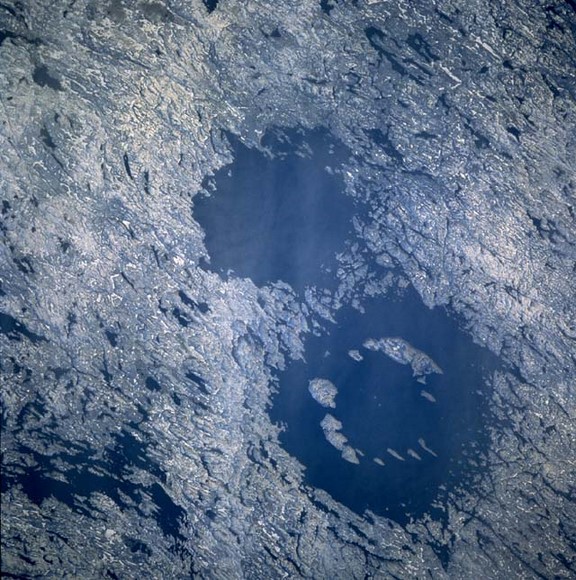Asteroids with moons, called binary asteroids, are fairly common in the solar system. But scientists haven’t been able to figure out the dynamics of these asteroids, especially how the moons form. But a group of astronomers studying binary asteroids say the surprising answer is sunlight, which can increase or decrease the spin rate of an asteroid. The researchers also say that since there are a number of “double craters” on Earth – side-by side craters that appear to have formed at about the same time — these binary asteroids may have hit our planet in the past. The image above is of twin circular lakes in Quebec, Canada, formed by the impact of an asteroidal pair which slammed into the planet approximately 290 million years ago. Similar double craters also can be found on other planets, as well.
Derek Richardson, of the University of Maryland, and Kevin Walsh and Patrick Michel at the Cote d’Azur Observatory, France outline a model showing that when solar energy “spins up” a “rubble pile” asteroid to a sufficiently fast rate, material is slung off from around the asteroid’s equator. This process also exposes fresh material at the poles of the asteroid.
If the spun off bits of asteroid rubble shed sufficient excess motion through collisions with each other, then the material coalesces into a satellite that continues to orbit its parent.
Link to an animated model of the spin-up and binary formation from two views, on the left is an overhead view. The right pane of the movie looks at the equator of the primary body, which is also the plane in which the asteroid’s satellite is formed (courtesy of the authors of the study).
Because the team’s model closely matches observations from binary asteroids, it neatly fills in missing pieces to a solar system puzzle. And, it could have much more down-to-earth implications as well. The model gives information on the shapes and structure of near-Earth binary asteroids that could be vital should such a pair need to be deflected away from a collision course with Earth.
The authors say that their current findings also suggest that a space mission to a binary asteroid could bring back material that might shed new light on the solar system’s early history. The oldest material in an asteroid should lie underneath its surface, explained Richardson, and the process of spinning off this surface material from the primary asteroid body to form its moon, or secondary body, should uncover the deeper older material.
“Thus a mission to collect and return a sample from the primary body of such a binary asteroid could give us information about the older, more pristine material inside an asteroid,” Richardson said.
Original News Source: PhysOrg


I like universe
It seems to me that closely orbiting asteroids would diverge in the Earth’s gravity. I believe it more likely that the impacters gravitationally fragmented (like Shoemaker-Levy) or split in the atmosphere prior to striking the surface.